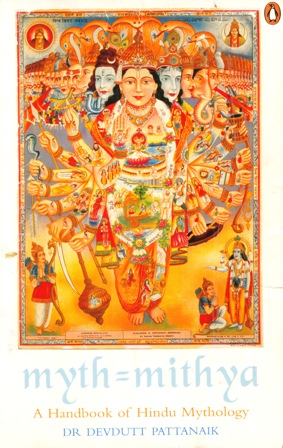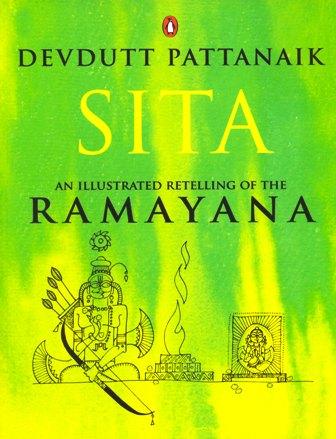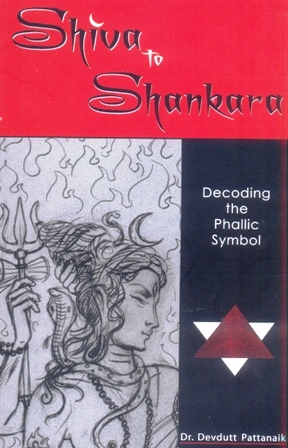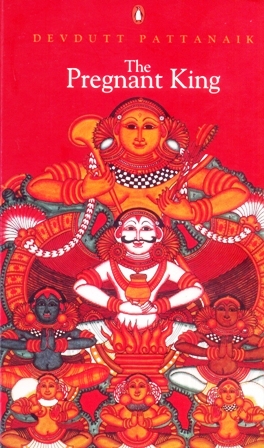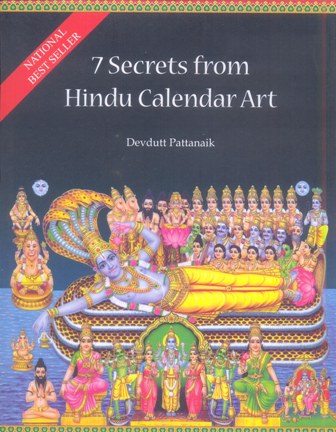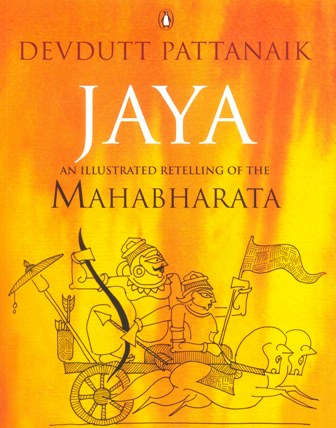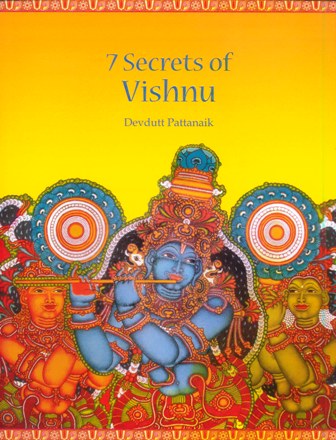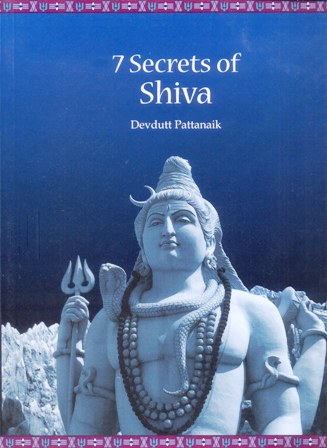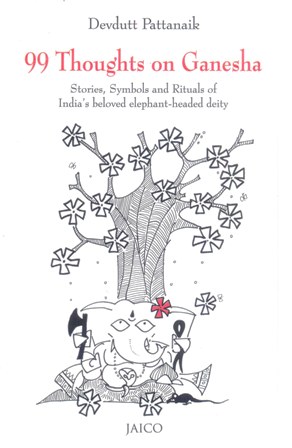-
Myth = Mithya: A Handbook of Hindu Mythology
Hinduism can be a puzzle or even an enigma to the uninitiated. There are so many different beliefs, so many rituals and so many myths and legends, it can be hard to follow. Myth = Mithya: A Handbook Of Hindu Mythology is an attempt by the author to shed light on this seeming tangle, to show the deeper meanings of the different stories. He explains about the Hindu Trinity and their Divine Consorts. He also goes into the puzzle of why Hindus believe in one Supreme Reality and yet claim the existence of 330 million Gods. The book explains concepts like the Pitr, Jiva, and about the Devas and the Asuras. He explains the significance of various rituals. He discusses how the warrior-like Kali and the benign Gauri are different forms of the same Goddess. He also compares the roles and the powers of the Trinity, Brahma, Vishnu and Shiva. He goes into the idea behind the various avatars or incarnations of the Preserver, Vishnu. He examines why the Rama and Krishna avatars have assumed such significance. Myth = Mithya: A Handbook Of Hindu Mythology also compares the two major epics, The Ramayana and The Mahabharata. It analyzes why the two avatars in the epics, Rama and Krishna, were so different. It shows that the age that these epics were set in demanded different perspectives to handle similar situations. This book is not a continuous narrative, it does not read like a novel. Instead, it is a source of reference for those who want to gain a deeper understanding of the stories and rituals and symbols that permeate the Hindu faith. The book is not aimed just at those who are non-Hindus. Even those who have been brought up in the Hindu faith can gain some deeper insights into their customs and beliefs through this book. Myth = Mithya: A Handbook Of Hindu Mythology also includes illustrations which are drawn by the author.
-
Sita
The chariot stopped far from the city in the middle of the forest. Sita alighted, eager to walk amongst the trees. The charioteer, Lakshman, remained seated. Sensing he had something to say, Sita paused. Lakshman finally spoke, eyes to the ground, Your husband, my elder brother, Ram, king of Ayodhya, wants you to know that the streets are full of gossip. Your reputation is in question. The rules are clear on this: a kings wife should be above all doubt. The scion of the Raghu clan therefore has ordered you to stay away from his person and his palace and his city. You are free to go wherever else you please. But you may not reveal to anyone you were once Rams queen. Sita watched Lakshmans nostrils flare. She felt his embarrassment and his rage. She wanted to reach out and reassure him, but she restrained herself. You feel your Ram has abandoned his Sita, dont you? she asked gently. But he has not. He cannot. He is God; he abandons no one. And I am Goddess; I cannot be abandoned by anyone. A mystified Lakshman returned to Ayodhya, while Sita smiled in the forest and unbound her hair. It is significant that the only character in Hindu mythology, a king at that, to be given the title of ekam-patni-vrata, devoted to a single wife, is associated with the most unjust act of abandoning her in the forest to protect family reputation. This seems a deliberate souring of an uplifting narrative. Rams refusal to remarry to produce a royal heir adds to the complexity. The intention seems to be to provoke thought on notions of fidelity, property and self-image. And so the mythologist and illustrator Devdutt Pattanaik retells the Ramayana, drawing attention to the many oral, visual and written retellings composed in different times, in different places, by different poets, each one trying to solve the puzzle in its own unique way. This book approaches Ram by speculating on Sita: her childhood with her father, Janaka, who hosted sages mentioned in the Upanishads; her stay in the forest with her husband, who had to be a celibate ascetic while she was in the prime of her youth; her interactions with the women of Lanka, recipes she exchanged, emotions they shared; her connection with the earth, her mother, and with the trees, her sisters; her role as the Goddess, the untamed Kali as well as the demure Gauri, in transforming the stoic prince of Ayodhya into God.
-
Shiva to Shankara: Decoding the Phallic Symbol
Shiva To Shankara: Decoding The Phallic Symbol, written by Devdutt Pattanaik, is an attempt by the author to reconcile with the differences of opinion regarding the meanings and the varied symbolisms behind the Shiva linga and other practices associated with the Hindu deity, Lord Shiva. The book dives into the rituals, metaphysics, stories, and symbols associated with Shiva, and deciphers the meanings and references behind the various aspects of Lord Shiva. It differentiates between Shankara, the householder, and Shiva, the hermit. Shiva is often associated with alchemy and asceticism, and there are sexual references, especially in the phallic Linga, that are interpreted in different forms by different schools of Hinduism. The sexual connotations of the Shiva lingam, which is ensconced within the female reproductive organ that is represented by the Yoni, is dealt with in this book. The author, Devdutt Pattanaik, is a respected mythologist and an expert in Hindu mythology. He was born in the year 1970, on December 11, and graduated from a medical school before he took up Comparative Mythology. Pattanaik is well-known for integrating the wisdom from Indian mythology into management practices. He has many books to his credit, including Shiva: An Introduction, 7 Secrets of Shiva, Fun in Devlok: Shiva Plays Dumb Charades, and The Book Of Ram.
-
The Pregnant King
‘I am not sure that I am a man,’ said Yuvanashva. ‘I have created life outside me as men do. But I have also created life inside me, as women do. What does that make me? Will a body such as mine fetter or free me?’ Among the many hundreds of characters who inhabit the Mahabharata, perhaps the world’s greatest epic and certainly one of the oldest, is Yuvanashva, a childless king, who accidentally drinks a magic potion meant to make his queens pregnant and gives birth to a son. This extraordinary novel is his story. It is also the story of his mother Shilavati, who cannot be king because she is a woman; of young Somvat, who surrenders his genitals to become a wife; of Shikhandi, a daughter brought up as a son, who fathers a child with a borrowed penis; of Arjuna, the great warrior with many wives, who is forced to masquerade as a woman after being castrated by a nymph; of Ileshwara, a god on full-moon days and a goddess on new-moon nights; and of Adi-natha, the teacher of teachers, worshipped as a hermit by some and as an enchantress by others. Building on Hinduism’s rich and complex mythology—but driven by a very contemporary sensibility—Devdutt Pattanaik creates a lush and fecund work of fiction in which the lines are continually blurred between men and women, sons and daughters, husbands and wives, fathers and mothers. Confronted with such fluidity the reader is drawn into Yuvanashva’s struggle to be fair to all—those here, those there and all those in between.
-
7 Secrets From Hindu Calendar Art
Hindu mythology abounds with fascinating gods, goddesses and characters whose visual representations - through calendar art - are equally colourful. Hindu calendar art may sem fantastic and kitsch, but it is in fact the most democratic expression of a mythic imagery that was once restricted to temple walls and palm leaf manuscripts. These portraits of the Hindu pantheon of gods and the stories that surround them can be found on the walls and puja rooms of almost every Hindu household in India. Rich in symbols, each image is a piece of an ancient metaphysical jigsaw puzzle. In this book Dr.Devdutt Pattanaik, India's renowned mythologist, decodes these symbols to reveal a wisdom that has nourished India for thousands of years
-
Jaya:An Illustrated Retelling of the Mahabharata
Jaya: An Illustrated Retelling of the Mahabharata by Devdutt Pattanaik is a simple retelling of the great epic in just around 350 pages. It provides a good introduction to the vast epic. Summary of Jaya: An Illustrated Retelling of the Mahabharata The Mahabharata, India's greatest epic, is a huge, sweeping work and is the longest Sanskrit epic. It tells the story of the Kuru family, and the events that lead to the fratricidal Mahabharata War. It describes the events during the 18-day war and its aftermath. In the Jaya: An Illustrated Retelling of the Mahabharata, Devdutt Pattanaik has condensed the epic into a small capsule. For those who do not know the story of the Mahabharata, this can be a good choice for a first book based on Mahabharata. What makes this book special is that it collects tales from various regional and folk versions in addition to the original Sanskrit composition. This book is divided into 108 chapters and is illustrated with around 250 simple line drawings done by the author himself. The author draws the reader into an interesting retelling of the Mahabharata. The book contains many intriguing tales from other versions of the epic, not just the major regional versions, but also those used in enacting the epic in folk arts like Chattisgarh's Pandavani, Tamil Nadu's Terukuttu and Karnataka's Yakshagana. The book contains stories of Aravan, Barbareek, Jaimini, Astika and Madhavi. It also highlights some intriguing traditions like the Draupadi temples in Tamilnadu where she is worshipped as a Goddess. It devotes pages to the Mahabharata versions of Sanskrit Classics like Shakuntalam and Ramayana. The author also devotes a section to dating the Mahabharata War based on the detailed astronomical information provided in the book, like the position of certain constellations etc. By bringing together many prevalent versions of the Mahabharata, he gives a pan-Indian view of the epic that has shaped the history and culture of the country over millennia. General Reception The book has become a popular choice for those who want to read the story of the epic for the first time as well as those who want to know even more about the Mahabharata and its sweeping influence on the country's culture and traditions. This highlight of the book is its simple style and the author's own interpretations of various incidents in the epic.
-
7 Secrets of Shiva
Smeared with ash, draped in animal hide, he sits atop the snow-capped mountain, skull in hand, withdrawn, with dogs for company, destroying the world with his, indifference. He is God who the Goddess shall awaken. His name is Shiva. Locked in his stories, symbols and rituals are the secrets of our ancestors. This book attempts to unlock seven. About The Author Dr Devdutt Pattanaik is a medical doctor by training, a marketing manager by profession and a mythologist by passion. He lectures extensively on the relevance of sacred stories, symbols and rituals in modern times. His books include 7 Secrets of Hindu Calendar Art, Shiva: An Introduction, Vishnu: An Introduction, Devi: An Introduction, Hanuman: An Introduction, Lakshmi: An Introduction, Krishna: An Introduction, Shiva to Shankara: Decoding the Phallic Symbol, Goddesses in India, Man Who Was a Woman and Other Queer Tales from Hindu Lore and Indian Mythology: Stories, Symbols and Rituals from the Heart of the Subcontinent.
-
99 Thoughts on Ganesha
In the game of cricket, having scored 99 runs, when a bats-man stands poised on the threshold of that much coveted century, he experiences the moment that is best associated with Ganesha. Fear and uncertainty envelope him; between him and his achievement stand hurdles, both real and imaginary: a possible spin from the bowler can overwhelm him, his own anxiety can paralyze him, cheering fans can distract him. He needs divine intervention then. He needs to focus, get rid of all hurdles, perform, get the final run, and achieve what he so longs for. In other words, he needs to think of Ganapati. This book brings together 99 meditations to better understand the stories, symbols and rituals of that ador-able elephant-headed Hindu god who removes hurdles and brings prosperity and peace. Known variously as Ganapati, Gajanana, Vinayaka or Pillayar, he can help all of us score a century in the game called life.

